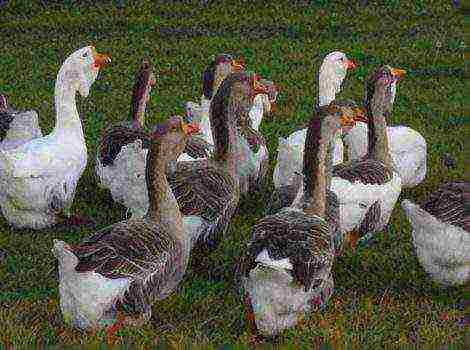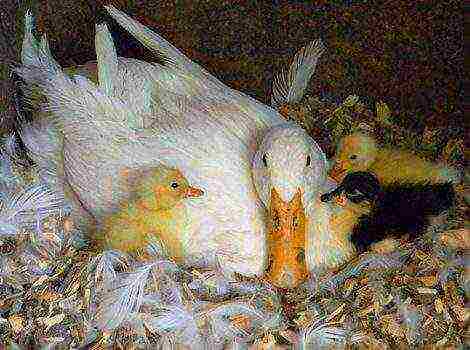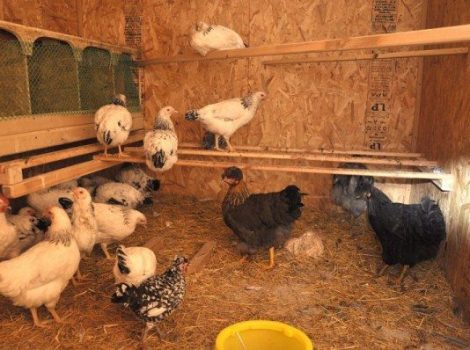Content
Growing broiler ducks at home
In terms of domestic poultry farming, broiler ducks are very popular with farmers due to their high growth rates and low-cost maintenance. Poultry meat has a high nutritional value, contains a large amount of useful macro- and microelements, vitamins, amino acids.
When breeding broiler ducks, you must follow a number of simple requirements and rules.
Broiler duck breeds
Broiler is a concept that unites all artificially bred poultry meat breeds. The existing broiler duck breeds were obtained by selective crossing of two varieties - Peking White and American Musk.
The more common type of broiler duck breed in breeding is the Peking ducks. In about two and a half months, with proper cultivation, the cross quickly gains more than three kilograms. Egg production of Peking ducks begins at the age of 25-26 weeks. This species was used in poultry farming to breed one of the large breeds - "Cheri-Veli", which is distinguished by high growth rates, excellent taste properties of liver and meat.
The meat of Muscovy ducks is similar in taste to the meat of wild relatives. Representatives of this cross can do without water bodies, but they absolutely do not tolerate subzero temperatures, therefore they are suitable for breeding, breeding exclusively in warm regions of our country. Duck weight - 3-3.5 kg, drake - 6 kg.
Another popular breed that was bred by French breeders is the Mulard. The cross was created by crossing the Peking and Musk breeds. Ducklings, regardless of the type of feeding chosen, grow very quickly, gain weight, and adapt well to various weather and climatic conditions. The cross is ideal for intensive feeding. For successful fattening of Mulardam at the age of 25-28 days, claws and beak are trimmed.
Mulard meat contains minimum amount of fat, has a delicate taste, is considered dietary... It is possible to breed a cross only artificially, since the female is initially sterile. Ducklings of this variety can be obtained by keeping common ducks and Peking drakes together.
On the territory of the former CIS there were other promising, productive breeds were bred based on Peking and American Musk:
- "Medeo".
- "Moscow White Duck".
- Blagovarskaya.
The birds of these crosses are not pretentious about the conditions of keeping, they quickly gain weight with minimal feed costs, and have high egg production rates.... The weight of ducklings by two months is three to four kilograms, which can be considered a very good indicator.
Meat broilers of the Agidel breed, bred thanks to the efforts of domestic breeders, are characterized by high profitability. Cross every year is gaining more and more popularity in poultry farming. You can grow this variety without problems at home, in small farms.
You will also be interested to know about:
- Incubation of duck eggs.
- Description and characteristics of Agidel broiler ducks.
- How to grow mulard at home.
- How to breed a Peking duck at home.
Broiler ducks perfectly adapt to our weather and climatic conditions, are not pretentious to the conditions of detention, do not require high-calorie concentrated feed, are distinguished by high egg production (120-150 eggs per year), productivity, have a calm character and disposition. Breeding is possible in incubators and brood ducks.
Unlike representatives of other breeds, broilers "Agidel" are not so susceptible to diseases... The survival rate of young animals is 98-99.5%. On the basis of this breed, two crosses were bred in the process of selection - "Agidel 34", "Agidel 345".
The most common breeds:
- Mulard;
- Super M4;
- Agidel;
- Indian runner;
- Cherry Valley;
- Hungarian variegated;
- Medeo;
- Moscow White Duck.
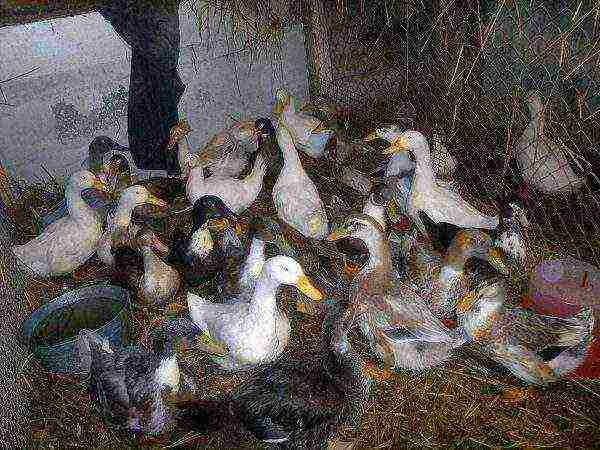
Growing features
Growing broiler ducks at home occurs mainly floor method... For this reason, a fairly spacious, dry place is allocated for keeping poultry. The room must first be disinfected, have an established ventilation system.
When growing broilers, you need to pay attention to lighting, humidity levels, microclimate, temperature conditions... During the first week of life, so that the ducklings do not rush about in panic, do not injure each other, the room should be lit 24 hours a day. Daylight hours are gradually reduced to 9-10 hours. Good air exchange is very important in summer.
The humidity level in the poultry houses is 65-70%, the temperature is not lower than 23-24 degrees. If the correct temperature regime is not selected, the ducklings will be inactive, lethargic.
Poultry should not be kept in small-sized poultry houses. With overcrowding, broilers feel uncomfortable, growth slows down, development of ducks, poorly gain weight. Up to a month old, 16 individuals can be accommodated on one square meter, further on 1m2 the best option is seven to eight ducks.
The floor is lined with a 15-20 cm layer of bedding made of hay, straw, peat, shavings. To reduce the moisture level, as an additional disinfection, lime-fluff is poured under the bedding - 0.5 kg per m2.
Broiler duck rearing period is three months, after which the bird begins to form "cones", which are difficult to pluck. During the first 12 weeks of fattening, the body weight of the ducks is 5.5-6.5 kg. The formation of "bumps" occurs during the juvenile molt, which begins at about the age of 60 days. The need for feed is increasing, the carcasses are losing their presentation.
Some farmers, owners of household plots, prefer to raise broiler ducklings not at home, in natural conditions, on reservoirs for four to five months. This method allows you to reduce feed costs, but allows you to grow only one livestock per season. When keeping ducks on pasture, it is difficult to achieve the desired weight inherent in the genotype of the breed.
The construction of the building does not require large financial costs, it is ideal for keeping broiler breeds. When planning to breed broiler ducks in the cold season, the poultry house is insulated with mineral wool, plastic wrap. The floors are disinfected, a two-layer bedding made of hay and straw is laid, and ventilation is organized.
A spacious area in front of the poultry house is set aside for walking the birds, fencing it around the perimeter. On a fenced area, closed-type drinkers and feeders are installed. Open drinkers should not be installed in duck quarters or walking areas. Ideally, if a small pond is equipped on the site.
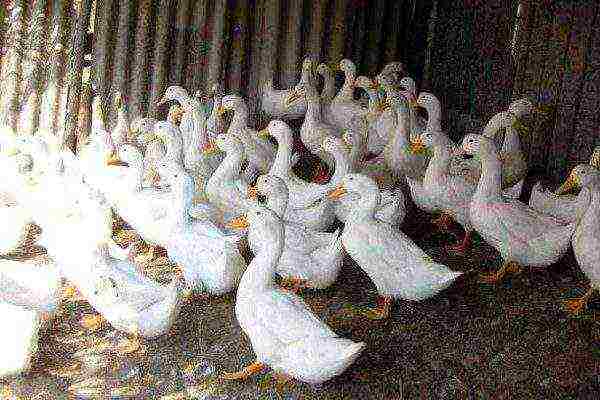
Keeping ducklings in cages
According to experienced farmers, in the first 10-15 days of life, broiler ducklings should be kept in cages in small groups. This method facilitates the care of the bird, allows you to mechanize the feeding process, and automate the water supply. This method of growing and keeping broiler ducks is often used in poultry farms and poultry farms. Since the ducklings are limited in movement, the increase in live weight increases, which reduces the cost of compound feed.
Unfortunately, there are no ready-made special cells on sale., so if you decide to keep ducklings in a similar way in a personal farm, you need to build poultry cages yourself.
Poultry farms practice growing rocking broilers in stationary summer "camps", lightweight poultry houses, assembled from wood or metal elements. Considering the high consumption of bedding material, a mesh deck made of durable materials is used.
Features of feeding at home
For the successful development and health of broiler ducklings from the very first day, it is very important to choose the optimal regimen and diet. It is imperative that ducklings be given food in the first 16-18 hours of their life. The first feeding is very important not only for the normal development, but also for the life of the young.
For the first feedings, finely chopped boiled eggs are used, a starter feed developed according to a special formula. In the first week of life, ducklings are fed seven to eight times a day, gradually transferring the young to 4 meals a day.
As they grow up, solid, concentrated feed is gradually introduced into the bird's diet. (compound feed), food additives, so as not to cause problems in the digestive tract. The feed should be nutritious, balanced in the content of crude proteins, fiber, phosphorus, amino acids, macro- and microelements.
In the first 20 days in the feed of ducklings per 100 g should be:
- 20% crude protein;
- 5% fiber;
- 25% calcium;
- 08% phosphorus;
- 05% sodium;
- wheat - 18%.
According to experienced farmers, it is advisable to give ducklings concentrated feed only up to three weeks of age... After that, the bird is gradually transferred to grain feed with the addition of greens, since ducks are herbivorous species of birds.
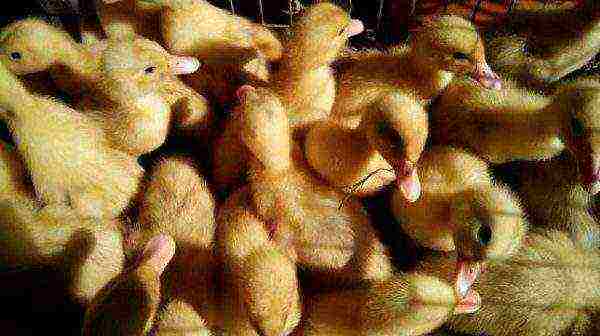
If you suddenly change the type of feed, transfer the ducks to combined concentrated feed, the bird can lose a lot in weight. It is possible to transfer ducks completely to grain from the third week of their life. If broilers are transferred to pasture, they will gain weight more slowly and may not reach their optimal weight.
It is necessary to enrich feed with food additives as the poultry grows and develops, tracking the indicators of live weight gain. Special feeds, premixes, bone meal, herbal meal, fish oil, eggshells, mash, cooked in skim milk, are used as nutritional supplements. You can diversify the diet of broilers with boiled root vegetables, fresh herbs, vegetables.
When feeding laying hens, by the time of egg production, the individual should have a normal live weight. It is recommended to use complete combined feed. The feed should contain two or three types of grain, 10% of the total mass of proteins, 7% of fiber, up to 10% of grain waste, 4% of animal feed, 5-6% of mineral feed.
Ducks eat well green fodder, root crops, combined silage... The daily energy requirement is 556-605 kcal, 38-46% of crude protein. Feed should be fortified with calcium, magnesium, phosphorus.
With a combined type of feeding, the diet of laying ducks should consist of 45-55% grain solid feed, 55% of feed mixtures. Laying hens are fed three times a day. In the first half of the day, they give wet food, mash on skim milk, milk, grain mixtures at night.
The amino acid composition can be improved by adding legumes to the compound feed. With a decrease in productivity to 55-60%, part of the compound feed is replaced with grain. After the completion of the egg production cycle, 30% of the total ration is grain, 70% of compound feed.
Diseases of broiler duck breeds
Broiler ducks susceptible to infectious, viral, bacterial, non-infectious systematic diseases... The most commonly diagnosed diseases in broiler ducklings include:
- hepatitis;
- paratyphoid;
- tuberculosis;
- hymenolipidosis;
- salmonellosis;
- fusariotoxicosis.
If you do not choose the right diet, broiler ducklings are diagnosed with vitamin deficiency-A. It is manifested by a decrease in activity, lethargy, conjunctivitis, loss of appetite, developmental delay. Dry eyes, the appearance of ulcers on the head and neck are noted in the bird.
With a lack of vitamin E in the bird, muscle cramps, spasms, loss of appetite, and a weak pulse are noted. For treatment, tocopherol is used, which is added one drop at each feeding. For prevention, young animals are given grain mixtures, fresh vegetables, hay flour.
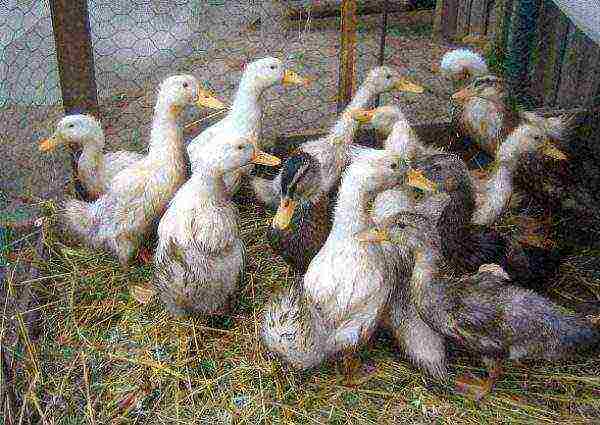
With a lack of mineral components, biologically active substances, broilers develop Urovska disease, in which ducklings begin to pluck feathers, eat inedible objects, bedding, soil, stones. For treatment, iodized salt and crushed bone meal are introduced into the diet.
Ducklings under the age of 30 days are prone to cuticulitis. The disease is accompanied by profuse diarrhea. In the feces, residues of undigested feed are noticeable. The bird loses weight, refuses feed. To eliminate the first symptoms, nicotinic acid, vitamin A, and iron sulfate are introduced into the diet. Several crystals of manganese can be added to the water.
Common broiler diseases include omphalitis, catarrh, partial blockage of the goiter... Ducks refuses to feed, becomes sedentary, lethargic. In case of non-observance of the temperature regime, high humidity in poultry houses, the development of colds, pathologies of the respiratory system (sinusitis, flu) is not excluded.
For the treatment of infectious diseases, on the recommendation of a veterinary specialist, antibiotic therapy, tetracycline drugs are prescribed. The incurable diseases of broiler ducks include typhoid, cholera.
For the prevention of infectious and bacterial diseases, it is necessary to create optimal conditions for keeping poultry, choose nutritious, fully balanced feed for feeding, introduce additional feed additives and premixes into the diet.
Reviews
According to experienced farmers, the most unpretentious in the cultivation of Mularda. With any type of feeding, the cross quickly gains weight. Like the Musk breeds, the Mulards are in good health, have a calm disposition, and are quiet. Not suitable for seasonal breeding. Many breeders breed Mulard because of delicious, juicy, tender meat, duck liver.
Due to the high cost of ducklings, the lack of a stable market for meat products, some farmers prefer the Hungarian variegated cross... Representatives of this variety have a lower cost, are not inferior in productivity to Mulard.
The Peking breed has earned positive reviews. Ducks grow quickly, gain weight, are distinguished by endurance, high egg production rates. At 50 days of age, they reach four kg.The most intensive growth is noted at 6-8 weeks of age. The meat is juicy, tasty, but fibrous in comparison with other breeds.
Despite the simple keeping of broiler breeds of ducks, in order to raise a healthy livestock of poultry, it is necessary to provide optimal conditions for keeping and feeding.
By choosing the right balanced diet, you can get meat that is excellent in taste and nutritional properties, and profit from the sale of carcasses. The type of feeding largely depends on whether the ducks are raised for meat or as breeding stock for breeding.
